Socket 940 Roundup: Motherboards for the Athlon64 FX
by Wesley Fink on December 18, 2003 1:39 PM EST- Posted in
- Motherboards
Asus SK8N: BIOS and Overclocking
BIOS
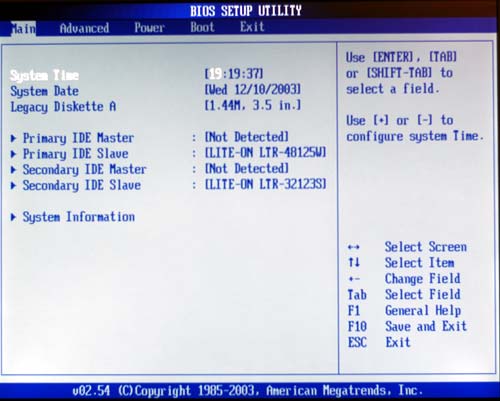
Asus uses AMI BIOS on almost all of their current boards, including the SK8N. Major categories are across the top and each category has many submenus.
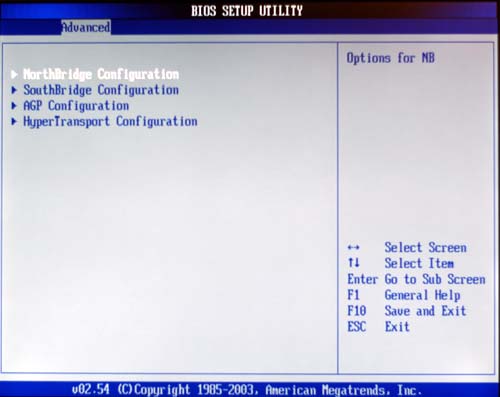
Most of the adjustment options that we normally use are in the Advanced section, which includes Northbridge Configuration, Southbridge Configuration, AGP Configuration, and HyperTransport Configuration.
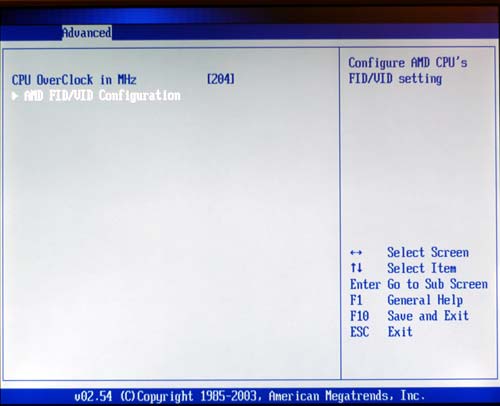
While the SK8N has a reorganized BIOS to improve understanding, even the 1004 BIOS for the SK8N still uses an arrangement that can be confusing. Adjustments for multipliers and voltage are under “Advanced” in the “AMD FID/VID Configuration” sub-menu.

While there is an overall CPU voltage adjustment in another menu, the fine tuning is done in the “Hammer VID” submenu.
Multipliers can be adjusted in the “Hammer FID” submenu. A wide range from 4 to 20 is available with half multipliers. As already mentioned, Asus has reworked the arrangement and descriptions in the SK8V BIOS that we will be examining later. Unfortunately, the SK8N arrangement is just as obscure as ever.
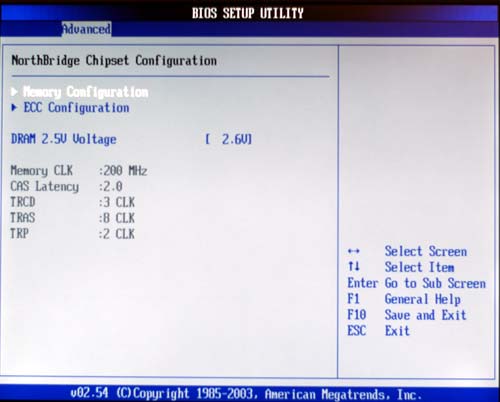
Adjustments for memory are under “Advanced”, “Northbridge Chipset Configuration”. Once you locate them, you will find a complete range of memory timing adjustments, but a limited vDIMM range to 2.7V.
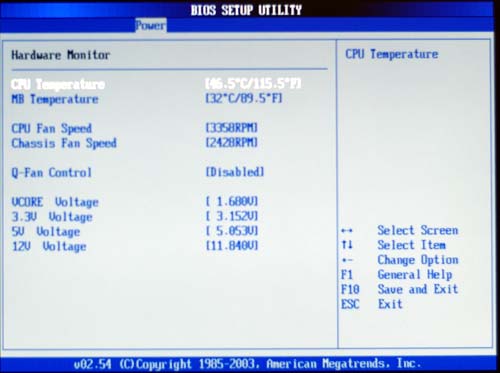
PC Health information is very complete, and can be found under the Power Menu, “Hardware Monitor” submenu. You will find system temperatures, fan speeds, and voltages. There are also controls for the Asus Q-fan utility, which enables fan speeds to be controlled by temperature.
FSB Overclocking Results
We have not found the Athlon64 FX to be a particularly good overclocker, which is not a surprise for a new top-line processor. However, with the recent Asus SK8N BIOS updates, we were able to squeeze more from the FX than we have seen in the past.| Front Side Bus Overclocking Testbed | ||
| Default Voltage | Maximum Overclock | |
| Processor: | Athlon64 FX51 2.2GHz |
Athlon64 FX51 2.2Ghz |
| CPU Voltage: | 1.5V (default) | 1.65V |
| Cooling: | Cooler Master Silent K8 Heatsink/Fan | Cooler Master Silent K8 Heatsink/Fan |
| Power Supply: | Enermax 465W | Enermax 465W |
| Maximum OC: | 2346MHz (+6.6%) 11x213 |
2452MHz (+11.5%) 12x204 |
The above overclocking setup at default voltage allowed us to reach the highest stable setting of 213 (852 HT). The highest MHz speed achieved was at 12x204 or 2452MHz at 1.65V. Higher overclocks may be possible at higher voltages, but we were not comfortable running greater than 10% voltage increase with air cooling.
The SK8N, particularly with the 1004 BIOS, has the tools needed to overclock an FX processor effectively. The only adjustment that is a bit lacking is memory voltage or vDIMM, which only allows adjustment to 2.7V. This is less of an issue with Registered memory than it might be with standard unbuffered DDR, where many high-end manufacturers are now certifying performance to 3.0V.










10 Comments
View All Comments
AnonymouseUser - Saturday, December 20, 2003 - link
Since this review is for the Athlon64 FX motherboards, shouldn't the links for the "Anandtech Deals" (just below the title) be for Athlon64 FX (socket 940) instead of the non-FX 3200+ (socket 754)?O_o
Wesley Fink - Saturday, December 20, 2003 - link
#7 -The scores with the 11/03 nVidia platform drivers combined with Catalyst 3.9 and the latest BIOS' we tested have dropped the GunMetal 2 benchmarks to those reported in this review. We have discussed the very unusual GunMetal scores we got in the past with Yeti Studios who is looking into the scores.
At this point, we are concerned that the GunMetal 2 bechmarks are really telling us very little about the performance of the boards and systems we are testing. Unless Yeti can update or explain what we have been seeing in Socket 940 scores, we will likely drop GunMetal 2 from our benchmarks.
We apologize for the confusion regarding GunMetal 2 bechmarks, but we have shared with you over several reviews our growing skepticism over their validity in benchmarking FX and Opteron.
TrogdorJW - Friday, December 19, 2003 - link
#7, if you look at those benchmarks in question, the results are HIGHLY questionable in the original benchmarks. They even mentioned it at the bottom of the page:"The astounding scores in GunMetal 2 by the Dual-Channel Opteron and Athlon64 FX51 are difficult to explain, since they are not duplicated by our single-channel Athlon64 benchmark. We were convinced that these scores on the original Opteron must be a fluke until they showed up again in our tests and retest of the K8NNXP-940 Dual-Channel."
My bet is that the earlier versions of the GunMetal benchmark were in some way flawed. Perhaps it was a driver issue, and the game was really only rendering about 2/3 of the screens that it was reporting. Given that all the other systems appear to be close to maxed out on frame rate by the graphics card, the FX and Opteron scores were initially incorrect and have now been fixed.
justly - Friday, December 19, 2003 - link
Wesley Fink, I have had issues with previous Anandtech articles and I thought (or at least was hopefull) that they would happen less often with some of the new staff. I now regret being so hopefull as I am still seeing the same problem.What I would like to know is what would cause the gun metal benchmarks on the Gigabyte K8NNXP-940 to drop 25% or more since the review of that same board on 9 Oct (there was even a link to this article on page one).
I realize that the motherboard and video drivers have changed along with some hardware, and BOIS updates mentioned on page 1 (stating that they "offering improved performance and added features"). The thing is that none of these changes should lead to this kind of preformance hit. What is the story here, was there a mistake in benchmarking, if so what article is correct, if not how do you explain this since most of the other benchmarks on this board varied (an estimated)5% or less.
Icewind - Friday, December 19, 2003 - link
Doubtful #5 as there is no BIOS option to enable or disable it for the VIA boards.bex0rs - Friday, December 19, 2003 - link
The integrated LAN on the SK8N is 10/100 only, not gigabit as mentioned several times.http://www.asus.com/prog/spec.asp?m=SK8N&langs...
http://www.realtek.com.tw/products/products1-2.asp...
Also, would there be any way to run the HT bus on the VIA boards at 600 to make a determination if that is the limiting factor on nV's implementation?
Wesley Fink - Thursday, December 18, 2003 - link
#1 - You are correct, and page 4 has been corrected. The SATA ports for the SK8N were correctly stated as 2 in the Feature listing for the 4 motherboards.Icewind - Thursday, December 18, 2003 - link
Unless im mistaken #1, is that one right next to the CPU cooler itself in the picture below? Hard to judge from the contrastIcewind - Thursday, December 18, 2003 - link
Best to wait for the 939 pin socket without the unregistered memory modules. I know I will. Paired with a possible PCI Express, SATA 2.0, ATi's 420, 2004 is gonna be a freaking expensive upgrade but better get the best before I finally move outa my folks house.adipose - Thursday, December 18, 2003 - link
http://anandtech.com/mb/showdoc.html?i=1936&p=...On this page you state:
The IDE connectors, IDE RAID, and 4 SATA connectors are all in good locations. They should present no problems in most case designs.
But I believe the SK8N only has 2 SATA connectors, and I can only see two on the image.
-Dan